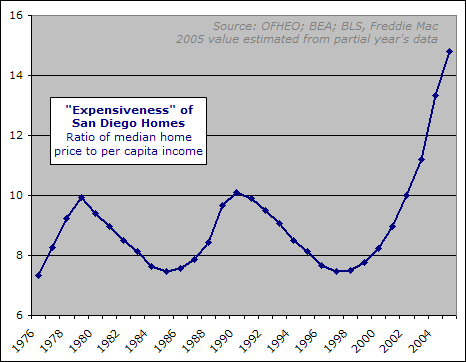This week’s Voice of San Diego article discusses what can and cannot be realistically forecast about the housing market at the current time. The premise is that while fundamental factors such as incomes, population, and housing supply can be forecast, the population’s tendency towards manic speculation cannot. And right now, the housing market is driven a lot more by the latter than the former, rendering (for instance) one-year forecasts kind of useless.
Looking further out, we can make a pretty confident prediction that the pattern displayed by this chart will continue, and that that ratio of home prices to incomes will end up much lower:

…but even then we can really only guess as to how much of that adjustment will be caused by home prices declining vs. incomes rising (a task made much more difficult by the fact that the political sphere can become involved in either factor). All in all, forecasting nominal home prices entails making a lot of assumptions.

It’s more likely that
It’s more likely that housing prices will fall, than wages go up too much. The Fed stated they are raising interest rates to head off inflation, and part of the reason is the tight labor market. I know they like rises in “real wages”, and just don’t want the rise to exceed the inflation rate. In any case, employer health insurance and pension funds and misc. expenses seem to absorb any direct wage increases given to workers.
Looking at the chart accompanying the article, we have to assume that wages were rising during those years, too, and yet we have the roller coaster graph. Why should this time be different? If wages rise, we would end up with a higher bottom, but then again, if interest rates rose to bring down wages, the bottom could hit more quickly.
It is the irrationality
It is the irrationality factor in the market that prevents accurately timing it. We would say the same thing if we were on a downcycle and still headed down – there’s no way to know how low it would go before bottoming out and starting back up again. Had this current upswing ended in 2002, at which point a lot of us already saw the parallels with the 12/1990 peak, we could have expected a decline similar to the one in the 90s. But it didn’t – the disconnect between population/wages and prices just got worse.
Having ventured into unprecedented increases since then it is not unreasonable to conclude that a subsequent correction could mirror the excess run-up in both amount and speed. If our pricing made it’s way into positive territory in 1999 or so and assuming it is at a plateau now, that means that this half of the cycle has already gone on for 6 solid years. If this cycle completes the way all the other cycles have in the past, you could fairly guess that it could take 6 years to correct and overcorrect before heading back up again.
The same types of market psychology that drives price increases also drives price declines. This has already been demonstrated in the real estate markets in the past. It is a blade that cuts both ways. Thus, irrational exuberance can turn to irrational pessimism in the markets.